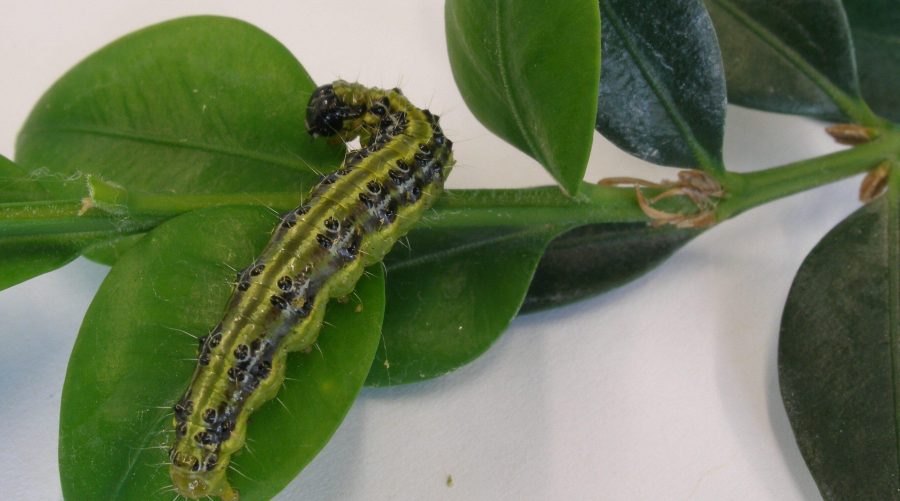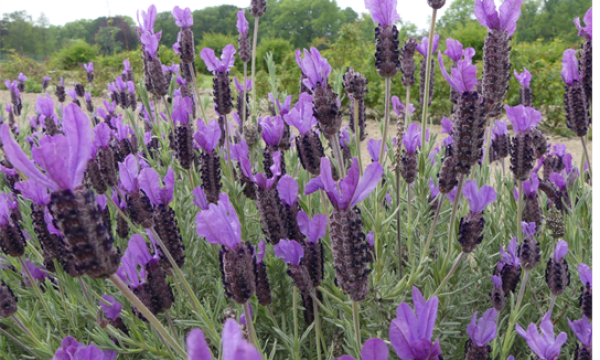Press release Environmentally friendly control boxwood moth

Good news for lovers of green gardens: bare bushes are a thing of the past. The boxwood moth will probably never disappear, but for the first time since its arrival, the pest pressure is decreasing. Damaged plants seem to recover well and pest control is perfectly achievable, provided timely actions are taken. In April, this means good pruning and weekly visual inspection of the plants.
These are the main conclusions after two years of research in SOSbuxusmot by ILVO and PCS in collaboration with Landelijke Gilden and AVBS. What is new since this year is the creation of a regionally distributed network of citizen observers, in order to be able to assess even more precisely when control is needed. The voluntary commitment of these citizens makes tailor-made regional advice possible
Two years of SOSbuxusmot
The box moth (Cydalima perspectalis) is a pest from East Asia that reached Belgium via Germany in 2010 and since spread rapidly throughout the country. The butterfly itself is beautiful, but the caterpillar is voracious and can eat an entire boxwood plant completely bare in no time. In order to get to know the new pest better and to correctly inform boxwood lovers, a research project was started in 2018. Research centers ILVO and PCS monitored the life cycle of box moth for two years and tested various control techniques. The national guilds and the floriculture and greenery federation AVBS translated the acquired knowledge into practical tips for garden owners at www.SOSbuxusmot.be. More than 20,000 Flemish people registered to receive the latest news and alerts via e-mail.
Pest pressure decreases
Two years after the start of the study, ILVO and PCS establish that the pest pressure seems to decrease in most places. Jochem Bonte (ILVO): "The cause of this is obvious: there is less boxwood and therefore less food for the caterpillars, and the remaining plants are well maintained and protected by their owners. The same trend towards smaller populations of box moth is also observed in our neighboring countries, such as in the Netherlands".
Control is possible
Box moth will not disappear altogether, but completely bare bushes are a thing of the past. After all, provided a correct and efficient approach is taken, the plague can remain well under control. The moths themselves are difficult to control, but the young caterpillars are not. Hanne Denaeghel (PCS): "The caterpillars occur in April, July and September. During those months, do a visual check on a weekly basis whether caterpillars are active in your box plants. After all, observation is the key to a good control strategy".
The caterpillars occur in April, July and September. During those months, do a visual check on a weekly basis whether caterpillars are active in your box plants. After all, observation is the key to a good control strategy
Step 1: Pruning and trimming waste to be composted
The best way to control the pest is to prune the plants at least once in spring or autumn, in addition to observing them. In this way you can remove hot spots of overwintering caterpillars. However, it is important to remove the pruning waste as soon as possible in a sealed bag and transport it to the recycling park, where it will be composted correctly (at a temperature above 60°C). Jochem Bonte (ILVO): "Do not throw the trimmings on your own compost heap under any circumstances, because the moth can easily spread again from there.”
Step 2: biological control
Treatment with biological insecticide may be necessary in case of severe infestation. Hanne Denaeghel (PCS): "Buy a product based on ‘spinosad’ and ask for advice on its correct use. Or call on a professional garden contractor, who has a wider range of pesticides available, including organic ones".
Step 3 (if necessary): Chemical control
The use of chemicals in the garden should always be the last option. This is no different when it comes to controlling box moth. However, it is important to know that the death of young birds is not caused by insecticides against box moth. This has been shown by research carried out in Belgium (Velt en Vogelbescherming Vlaanderen) and the Netherlands (CLM). Miet Poppe (AVBS): "The culprits turned out to be pesticides that are present in the fur of pets (anti-flea agent). Perhaps the tits used the poisonous hairs of cats and dogs to build their nests".
Step 4: Have patience, the plant recovers
A plant with caterpillar damage can fully recover if properly cared for. Even after severe infestation. It is therefore not necessary to remove plants that have been left bare. New shoots appear in the summer after 6 to 8 weeks. Miet Poppe (AVBS): "Tips for good care - watering, fertilizing, pruning - can be found on www.buxuscare.com, a website with which SOSbuxusmot works closely together.
Step 5 (if necessary): choose another type of boxwood
Plants that do not survive despite good care (e.g. due to repeated heavy infestation) can be replaced by a less susceptible species of boxwood. Katrijn Van Laere (ILVO): "After all, the box moth likes some boxwood species less, such as Buxus microphylla 'Rococo' and Buxus microphylla var. japonica. Fully tolerant species of boxwood are not yet on the market, but research into this is in full swing".
From now on, advice tailored to your region
Thanks to a newly created regional network of citizen observers, researchers can now monitor the distribution of boxwood moth even better and in more detail. The observers will, on a voluntary basis, search for box moth and its caterpillars in their boxwood plants on a weekly basis, and pass on their findings to the SOS box moth team. Marleen Van Der Velden (Landelijke Gilden): "From now on, we can also provide advice on the right time to control box moth, tailored to each region. That regional aspect is very important. After all, small variations in temperature can have an impact on the activity of the boxwood moth, and intervening at the right time is crucial for good control".
The regional aspect is very important. After all, small variations in temperature can have an impact on the activity of the boxwood moth, and intervening at the right time is crucial for good control".


